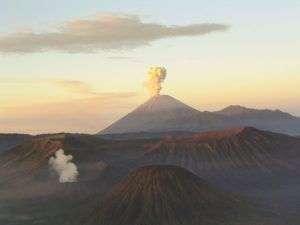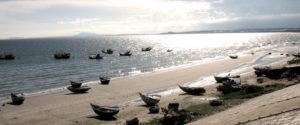Editor’s Introduction: Given Southeast Asia’s relative neglect in schools and higher education, the authors of this segment provide both a convincing case for Southeast Asia in the classroom and comprehensive teacher/student resources.
Burma, Thailand, Laos, Cambodia, Malaysia, Singapore, Indonesia, Brunei, East Timor, Việt Nam, and the Philippines— why is it important for middle, high school, and college students to learn about Southeast Asia? What might interest them about this area sprawling between the Indian and Pacific oceans, between India, China, and Australia?
Young people struggle to learn a wide range of subjects in school and as undergraduates. They often complain that what they learn has little relevance to their lives, yet learning about Southeast Asia can tie into many existing areas of study and link directly to important contemporary and future issues. Some curricular topics relevant to Southeast Asia include:
Geography. Southeast Asia is bracketed by active volcanoes, edged extensively by water (except for landlocked Laos) and geologically layered from sea level to fertile valleys; tiered hillsides of rice, tea, and spice fields; and fog-shrouded mountains. How has this profusion of geographical forms influenced the ways different groups of Southeast Asians have lived, eaten, dressed, and interacted with each other and with the rest of the world?
Climate Change. Many people in Southeast Asia live near or even below sea level. According to the International Panel on Climate Change’s 2014 reports, sea levels around the world are expected to rise as much as three meters in the next fifty to 100 years. Indonesia, the fourth-most populous country in the world, is also the fourth-largest contributor to greenhouse gas emissions (GHGs). Part of that comes from drying peat moss—as the rainy seasons become more intense and dry seasons lengthen, the peat that lies underneath most of the tropical rainforest dries out and releases carbon dioxide. And what about Cambodia? Although mostly inland, much of the country lies below sea level. Predictions for destructive climate change impacts are dire for Southeast Asian countries such as Việt Nam and the Philippines. What can be done to reduce the possible impact of climate change and the intensity and ferocity of tropical storms that may affect these countries?

Culture. Students might want to learn about the distinct and varied cultures found throughout Southeast Asia, made up of hundreds of ethnic and linguistic groups—the Moken of Burma or the Bajua of Indonesia, sometimes referred to as sea gypsies; the powerful Khmer empire that built Angkor Wat in Cambodia; overseas Chinese who settled in almost every Southeast Asian country; and the Indian diaspora throughout the area. How have the overlapping cultures affected one another? How do cultural forces and clashes impact nations, governments, and businesses?

Religion. Because of the long history of international trade, people in Southeast Asia have absorbed, shed, and altered many religions over time. In some places, people may profess a particular faith but adhere to more than one belief system. Are there similar situations students can think of in their own lives? What impact do multiple belief systems have when strongly held beliefs clash?
History. What students know of Southeast Asia seems generally bracketed by European colonization and the American Việt Nam War. Yet Southeast Asian history stretches back to the earliest days of Homo sapiens. History has brought traders and visitors from all over the world. How have these interactions affected Southeast Asia? Were the histories of the island nations more affected than those of the mainland countries?
Government. Southeast Asia boasts myriad forms of governance, including Parliamentary Monarchy, Communism, Socialism, Dictatorships, Islamic Law, Military Governments, and several forms of Democracy. How did each of these nations become governed as they now are? How do culture and religion shape governments and politics in the region?
International Politics. The nations of Southeast Asia belong to the Association of Southeast Asian Nations, or ASEAN. This year, ASEAN begins the process of regionalization— the creation of an international organization similar to the European Union. How will this union work? What are the biggest challenges? If the regionalization is successful, how does that impact international trade and political power?
Immigration. Immigration is an issue constantly in the news in the US. Southeast Asia struggles with its own problems of legal and illegal immigration. Philippine workers travel throughout the area seeking employment, and their remittances make up a huge part of the country’s income. Cambodian, Burmese, and Laotian workers cross the Thai border seeking higher pay. Thailand has long played a role in sheltering those fleeing war and violence from neighboring countries, sometimes willingly and patiently, and sometimes reluctantly. Immigrants from Eastern Europe and mainland Southeast Asia transit through Indonesia, hoping to reach Australia by sea and sometimes failing. How can countries that may struggle with internal poverty and ethnic tensions manage their Human Rights Commission (UNHRC) provide good support for the countries receiving refugees? Why or why not?

Popular Culture. Southeast Asian young people tweet, text, and Snapchat like their peers everywhere. The growth in smartphone use in Southeast Asia has exploded in the past decade. Fashion magazines, cult movies, YouTube videos, popular music, and dance reflect both the local culture and the international scene. Do you think internationalization of culture is changing attitudes and behaviors in Southeast Asia? Why does this differ from country to country and between different ethnic groups? Try watching some subtitled films, listen to dangdut and K-pop music, and check out Indonesian reggae. Graphic novels portray some of the world’s oldest stories, the Ramayana and Mahabharata. How did these ancient stories survive into modern times, and how have they been adapted from traditional dance and shadow puppetry? What does the “three finger salute” from The Hunger Games and George Orwell’s 1984 have to do with Thai politics?

The Arts. Those interested in the arts can revel in wayang from Indonesia, iconic pipes and other fantastic carvings from Burma and Malaysia, traditional court dances from Thailand, and the beautiful batik textiles and other cloths produced in much of Southeast Asia. Novels of war, love, and remembrance; travel writing; and plays and poetry give glimpses into a life very different from that in the global North. Why do you suppose gamelan has become popular all over the world, with gamelan orchestras throughout Europe? How have Southeast Asian fashion designers used batik and ikat textiles to make a splash in the international fashion scenes?
GENERAL INFORMATION AND SOURCES FOR SOUTHEAST ASIA
Exploring Asia Series/Newspapers in Education. This annual program includes curriculum plans and lessons for middle and high school teachers. The unit from 2012, “Islam in Asia,” is especially relevant to teaching about Southeast Asia. The 2010 lessons about human rights include a unit on censorship in Thailand. http://tinyurl. com/lbw8kwz.
Southeast Asia in World History (Oxford University Press, 2009). This book is a quick, reliable, straightforward account of Southeast Asia, country by country, from ancient times to (almost) the present. http://tinyurl.com/ odbgxk2.
The British Library, On-line Gallery (Online Museum Resources for Asian Art) . Another source on history and culture in Southeast Asia and other areas of Asia, this website provides access to some of its own collections and to that of other museums. Although much of the material concentrates on China and Japan, there is information specific to Southeast Asia, as well as to Islam, Buddhism, and Hinduism. http://afemuseums.easia.columbia.edu/.
Heilbrunn Timeline of Art History, The Metropolitan Museum of Art. This fantastic timeline provides much more information than art history. Users can choose from different areas of the world and then narrow down to a specific epoch. The succinct information includes history, trade, art, culture, and literature. From within the website, you can link to specific collections held at the Met or information about a single country or era; for instance, http://tinyurl.com/nnenw5u provides more detailed in formation about pre-Angkorian times in Việt Nam and Thailand.
The Asian Art Museum (San Francisco) has several indepth resources for educators, including lesson plans on Islam and Buddhism, the geography of Southeast Asia, wayang kulit (shadow puppetry), and key stories of Indonesia. http://tinyurl.com/nqkv5sh.
Stanford Center on International and Cross-Cultural Education (SPICE). This site publishes several Southeast Asia curriculum materials. The recently produced multimedia series My Cambodia and My Cambodian America won the AAS 2015 Franklin Buchanan Prize (EAA interview and review forthcoming). https://spice.fsi.stanford. edu/.
The Australian Government Department of Foreign Affairs Country Pages. Australia has a long history of interaction with Southeast Asia, especially with Indonesia, given its martime juxtaposition with the southern continent. Although the pages are not specifically for students, this is good general information about interactions between Southeast Asian nations and a different Western government than the US. http://tinyurl.com/onsl38b.
The World Factbook, CIA. This is an excellent source of basic information about nations throughout the world. Each country page has specific information on geography, people and society, government, economy, energy, communications, transportation, military, and transnational issues. Most terms used in the summaries are defined under the “references” tab. http://tinyurl.com/2h2e3k.
U.S. Energy Information Administration (EIA). This website has good, succinct information about the energy resources each of the world’s nations have, the types of resources, production, reserves, refining, exporting and importing, and renewable resources. Contrast, for instance, how much oil and natural gas, geothermal energy, and potential wind energy exist in Indonesia with the limited resources in Thailand. Some of the writing may be too esoteric for teenagers, but the graphics and summaries are quite accessible for that age group. http://www.eia.gov/.
Religions of Southeast Asia (PowerPoint). This is a well-done summary of the origins of the many religions of Southeast Asia, developed by Cindy Kleinmeyer, a political science PhD student at Northern Illinois University in 2004. The presentation includes information on the successive layers of religious practices in Indonesia, photos of some major Hindu sites in Indonesia, and a discussion about how Islam, as practiced in Indonesia and other parts of Southeast Asia, differs from what is practiced in the Middle East, as well as its prevalence in Malaysian religion and culture. The presentation includes information on Theravada and Mahayana Buddhism and is applicable for learning about Thailand as well. http://tinyurl.com/ l2wlnwb.
BBC News website. This site includes country-specific information for Thailand, Malaysia, and Indonesia. The site is easily accessible and readable for middle and high school students. http://tinyurl.com/nby5c62. The
Washington Post KidsPost online. Type in the country name and you will find good, brief articles on everything from history, culture, and language to the latest current events in Thailand, Malaysia, and Indonesia. The contents is well-suited for middle and high school students. http://tinyurl.com/ob2tgcu.
National Geographic online. The articles include good, basic information, and some specific stories highlight Southeast Asian ethnic group and regions. The photographs reinforce student understanding. The magazine does tend to concentrate on lesser-known geographic areas and cultures, but there is plenty of information on Malaysia, Thailand, and Indonesia in this essay. http:// www.nationalgeographic.com/
The Jakarta Post, The New Straits Times-Malaysia, The Straits Times-Singapore:
Each of these newspapers publishes English-language versions online. The Jakarta Post primarily deals with Indonesia and the Straits Times with Singapore. Despite some censorship issues in Singapore, the Straits Times online newspaper produces surprisingly candid pieces about international politics and affairs. It is fun and useful to read classified ads in these papers in order to gain a little insight into contemporary culture elsewhere. For instance, compare the rental prices of houses in Singapore to Indonesian homes for a shock.

